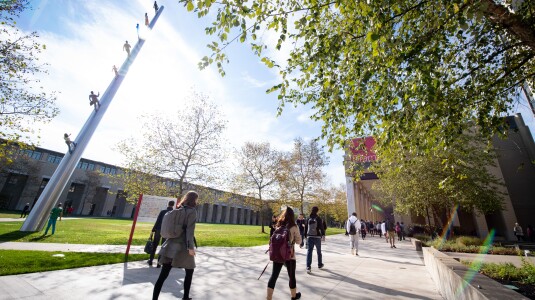Across many industries, machine learning is emerging as a critical technology for solving complex, real-world problems. From using data to predict health outcomes to making online transactions more secure, companies are finding new ways to use ML — and sometimes they need help.
Michelle K. Lee, in her role as vice president of the Amazon Machine Learning (ML) Solutions Lab at Amazon Web Services (AWS), wants to advance that process.
Prior to joining Amazon in 2019, Lee was an MIT CSAIL (formerly MIT Artificial Intelligence Lab) computer scientist, a tech executive who helped build a company that, like Amazon, grew quickly into a multi-national corporation, a professor, and a public servant. In the latter role, she served as the Under Secretary of Commerce for Intellectual Property and director of the United States Patent and Trademark Office (USPTO) from 2014 to 2017. In this position, Lee was the chief executive officer of one of the largest intellectual property offices in the world with around 13,000 employees and an annual budget in excess of $3 billion, and served as the principal advisor to the president on intellectual property policies. She is the first woman to hold this position in American history.
Amazon Science recently talked with Lee about her experiences at the patent office, her interest in artificial intelligence, the untapped potential of machine learning, why she was drawn to the ML Solutions Lab, and more.
Q. How did you get interested in machine learning?
I was born and raised in Silicon Valley, so I’ve been around technology my entire life. As a young girl, I loved tinkering, building and making things. I fondly recall building, with my dad, the Heathkit hand-held radio and the TV that eventually sat in our living room. This led me to study engineering and computer science at MIT. I first became interested in AI when I was a student at MIT. Back then, in the late ‘80s, everyone was excited about AI and how it might transform the world. That didn’t quite happen, but now that the cost of storage is lower, our computing power much greater, and cloud services more widely available, I do believe the time is ripe for AI and machine learning to achieve its promise and become widely available — to be democratized, if you will.
Q. How do you see that democratization being realized?
More customers from a broader range of industries are starting to use machine learning, and I expect that adoption will continue to accelerate. In the past, if I was in an area unrelated to the computing and machine learning industry, it was hard for me to tap into and take advantage of that functionality. Now I can be in a completely unrelated business, and I'm still able to explore, build, and deploy machine learning models to help improve my organization, to enhance my customer’s experience, or to solve a very challenging problem.
"Cerner used Sagemaker to query large and normalized patient data sets and built complex deep learning models to predict the onset of congestive heart failure up to 15 months before clinical manifestation."
— Cerner (@Cerner) December 9, 2020
@awscloud's Dr. Matt Wood (@mza) yesterday on the #reInvent stage pic.twitter.com/PyCGqIdvPO
For example, NASA partnered with my team to use machine learning to understand, and ultimately predict, the occurrence of superstorms. Additionally, and more recently, data scientists from my team worked with AstraZeneca to help pathologists accelerate the classification of tissue samples by utilizing computer vision models. That reduced the time it takes to classify samples by 50%, which means their pharmaceutical research can move faster — that’s very exciting! For another customer, Cerner, one of the largest publicly traded healthcare IT companies, we were able to build a solution that allows researchers to query autotomized and anonymized patient data records. They were able to predict congestive heart failure up to 15 months before a clinical manifestation. These are just a few examples, but there are many more across a wide range of industries.
Q. What challenges remain?
We're in the early stages. If you think of it as a baseball game, the machine learning and AI journey is in the first of nine innings. It’s still hard for some organizations to find the best machine learning use case for their business. Identifying one’s highest-value use cases requires understanding the current state of machine learning technology, assessing your data and prioritizing the business needs of your organization. Once your best use cases have been identified, implementation is often a challenge, as many organizations lack the expertise on their teams, or even compliant access to their data, to implement the machine learning solutions.
Q. Where does the ML Solutions Lab fit in?
The Machine Learning Solutions Lab addresses each of these challenges. It pairs the customer's team with AWS machine learning experts who are data scientists. This team of data scientists and business consultants works to help identify and build machine learning solutions to address high-value machine learning opportunities and a path to production. Once we develop that plan, we can even provide a professional services team to help implement if needed.
Introducing the Amazon ML Solutions Lab, a new program that connects machine learning experts from across Amazon with AWS customers. https://t.co/zvjtgoS11j
— Werner Vogels (@Werner) November 22, 2017
We also offer educational training for technical team members, the same machine learning curriculum we use to train AWS engineers and scientists. For business leaders, there’s training aimed at teaching them ways to think about AI so they can better understand both what is possible and how AI might be used to address their business challenges.
Not every problem is solvable by machine learning, but business leaders today should have some understanding of AI and ML, and when it can be used to achieve operational efficiencies and competitive advantage.
Q. Has COVID-19 changed what you are doing?
We're seeing an increased use of AI and ML in a number of areas in response to the pandemic, from research to healthcare. Rarely before has the pace of research and publication been so furious. That’s understandable given the global medical crisis we face. While more research is good, it is hard for scientists to discover research relevant to their work given the exponentially increasing volume of information.
That’s why AWS built the CORD-19 Search tool using services like Amazon Comprehend Medical and Amazon Kendra. This new search tool, powered by machine learning and hosted at CORD19.aws, allows researchers to get answers to questions like, “What do we know about COVID-19 risk factors?” and “Are IL-6 inhibitors key to COVID-19?” or “Which medications were most beneficial in the 2002 SARS outbreak?”
Built on the Allen Institute for AI’s CORD-19 open research dataset of more than 128,000 research papers and other materials, this machine learning solution can extract relevant medical information from unstructured text and delivers robust natural-language query capabilities, helping to accelerate the pace of discovery.
In the field of medical imaging, meanwhile, researchers are using machine learning to help recognize patterns in images, enhancing the ability of radiologists to indicate the probability of disease and to diagnose it earlier. More generally, all organizations are adjusting to the post-pandemic world, finding new ways to operate effectively and meet customer and employee needs as social distancing and quarantine measures remain in place. Machine learning is facilitating that shift by providing the tools to support remote communication, enable telemedicine, and protect food security, for example.
Q. What inspired you to choose Amazon?
In my prior position, I led a 200-year-old governmental agency, the United States Patent Trademark Office. Part of my job involved digitally transforming the agency. Because of my background at the MIT Artificial Intelligence Lab and with a big data company, I recognized that there was a tremendous opportunity to revolutionize the Patent Office’s business using AI and data analytics.
We implemented some basic AI and data analytics solutions to improve the quality and consistency of the patents issued by the patent office. What I came to realize is if the USPTO has machine learning opportunities, so does every organization. The challenge is to identify those opportunities and to have a plan and team to implement them. However, that is often easier said than done. At the USPTO, there was no way I could hire the talent — the data scientists or machine learning experts — that I have the privilege of working with today at Amazon. And that's what inspired me to lead the ML Solutions Lab at AWS.
As I mentioned earlier, we are a global team of data scientists and business consultants, who work side-by-side with our customers to identify their highest return-on-investment machine learning use cases and to help our customers implement them. What makes this fun and challenging is we do so through ideation sessions, hands-on-keyboard proofs of concepts to illustrate viability, and implementation to production. And we do so bringing learnings from 20 plus years of Amazon’s ML innovations in areas such as fulfillment and logistics, personalization and recommendations, computer vision, translation, fraud prevention, and forecasting and supply chain optimization.
Q. In your capacity as a leader, how do you view diversity?
Diversity in views and experiences is critical to innovation because, by definition, innovations require thinking outside of the box, finding a solution to an existing problem that no one has ever seen before. The broader the perspectives and experiences on the team, the greater the chances for that spark of innovation.
As a leader, I find that I make better decisions when team members challenge my thinking and offer contrary views. I welcome — in fact, I seek out — those contrary views, because the issues facing AI and ML require interdisciplinary approaches. No one person's going to have a complete view and perspective on all the issues relevant to AI and machine learning.
Q. What would you say to women considering a career in ML?
If that's your goal, pursue it with a passion. Don't wait for people who look like you to do what you know needs to be done. I have often been one of a few, or even the only woman, in the room or sitting at the table. Whether that was as a graduate student at the MIT AI Lab and the PhD program, or the first Asian American woman elected partner in my law firm, or the first woman appointed by the president of the United States to lead the United States Patent and Trademark Office. If I waited for people who looked like me to do what I did, I'd still be waiting.
That said, I am very encouraged to see the growing diversity within the field of AI and ML. We all have a long way to go still, but there are brilliant pioneers paving the way for future generations — and I look forward to seeing more in the future.


















